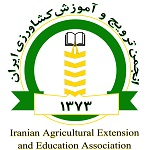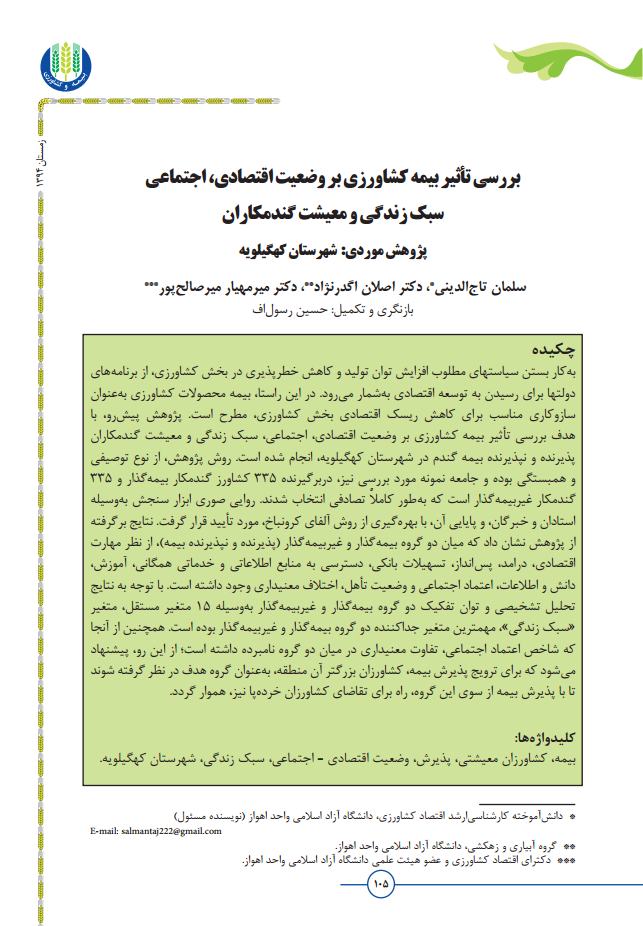

دوره 12، شماره 46 - ( 1394 )
جلد 12 شماره 46 صفحات 124-105 |
برگشت به فهرست نسخه ها
Download citation:
BibTeX | RIS | EndNote | Medlars | ProCite | Reference Manager | RefWorks
Send citation to:



BibTeX | RIS | EndNote | Medlars | ProCite | Reference Manager | RefWorks
Send citation to:
Tajeddini S, Agdarnezhad A, Mirsaleh pour M M. Investigation on the Effects of Agricultural Insurance
on Socio-Economic Situation and Lifestyle & Livelihood
of Wheat Growers
Case Study: Kohgiluyeh Province. QJIA 2016; 12 (46) :105-124
URL: http://journal.sbkiran.ir/article-1-51-fa.html
URL: http://journal.sbkiran.ir/article-1-51-fa.html
تاج الدینی سلمان، اگدرنژاد اصلان، میر صالح پور میر مهیار. بررسی تأثیر بیمه کشاورزی بر وضعیت اقتصادی، اجتماعی
سبک زندگی و معیشت گندمکاران
پژوهش موردی: شهرستان کهگیلویه. فصلنامه بیمه و کشاورزی. 1394; 12 (46) :105-124
چکیده: (211 مشاهده)
The adoption of desirable policies for increasing production potential and reducing
risk in the agriculture sector is among the government’s programs for economic
development. In this relation, agricultural crop insurance is considered an appropriate
mechanism for reducing economic risk in the agriculture sector. This descriptive and
correlational research intended to study the effects of agricultural insurance on the
livelihood of wheat growers in Kohgiluyeh city. The research sample consisted of 335
insured and 335 uninsured wheat growers who had been selected randomly. The face
validity of the research tool was confirmed by the relevant professors and elite, and
its reliability through using the Cronbach alpha method. The results of the research
showed that , there were significant differences between the two groups of the insured
and uninsured wheat growers (those who adopted the insurance policy and those who
did not) with respect to economic skills, income, saving, banking facilities, access
to public resources, education, knowledge and information, social trust, and marital
status. By Considering the results of the discriminant analysis and the ability to
separate the insured group from the uninsured by using the 15 independent variables,
“lifestyle” was the most important variable that separated these two groups from each
other. Moreover, since the indicator of social trust was significantly different in the two
mentioned groups, we suggest that the larger landowners in the region be considered
as target group for promoting adoption of agricultural insurance policy so that, when
they adopt it, the ground is prepared for its adoption by the small landowners.
risk in the agriculture sector is among the government’s programs for economic
development. In this relation, agricultural crop insurance is considered an appropriate
mechanism for reducing economic risk in the agriculture sector. This descriptive and
correlational research intended to study the effects of agricultural insurance on the
livelihood of wheat growers in Kohgiluyeh city. The research sample consisted of 335
insured and 335 uninsured wheat growers who had been selected randomly. The face
validity of the research tool was confirmed by the relevant professors and elite, and
its reliability through using the Cronbach alpha method. The results of the research
showed that , there were significant differences between the two groups of the insured
and uninsured wheat growers (those who adopted the insurance policy and those who
did not) with respect to economic skills, income, saving, banking facilities, access
to public resources, education, knowledge and information, social trust, and marital
status. By Considering the results of the discriminant analysis and the ability to
separate the insured group from the uninsured by using the 15 independent variables,
“lifestyle” was the most important variable that separated these two groups from each
other. Moreover, since the indicator of social trust was significantly different in the two
mentioned groups, we suggest that the larger landowners in the region be considered
as target group for promoting adoption of agricultural insurance policy so that, when
they adopt it, the ground is prepared for its adoption by the small landowners.
ارسال پیام به نویسنده مسئول
| بازنشر اطلاعات | |
 |
این مقاله تحت شرایط Creative Commons Attribution-NonCommercial 4.0 International License قابل بازنشر است. |



